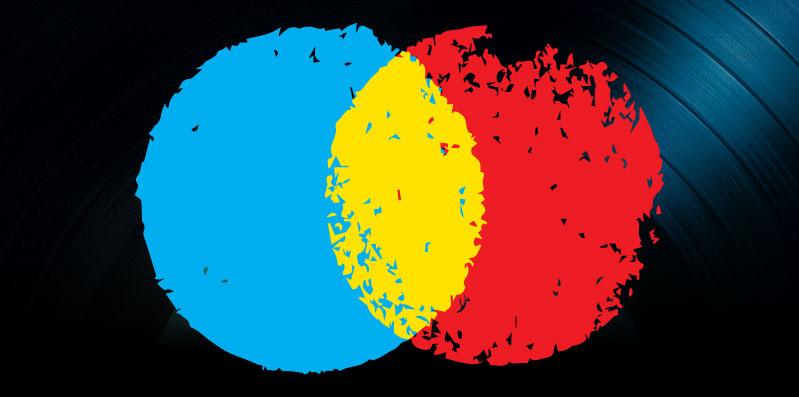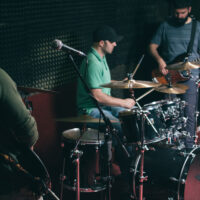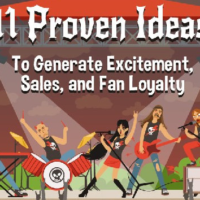
Music and Merchandise
The following is a re-post of an article from early 2010. John Mathiason has since opened his own management company, Candy Shop Management. You can check out his company and clients on the Candy Shop Management website linked below or on Facebook.
John Mathiason is an Artist Relations Executive at a Merchandising Company called Cinder Block. Cinder Block handles Merch for both household names and indie artists. Prior to working at Cinder Block John tour managed Sponge and managed several other successful artists. John talked about some of the qualities bands should be looking for in a merchandising partner and some of the moving parts of successful merch design and sales.
MC:
One of the reasons I wanted to interview you, because you’re always an interesting conversation is because you once told me, “People think Merchandising is just printing t-shirts but it’s a lot more than that.” I’d love for you to explain what people should be looking for in a merchandise partner and what it is you do.
JM:
As an artist relations rep, you’re doing acquisitions – trying to find bands or comics or any company that need merchandising fulfillment. It’s interesting always how you come across in discussing stuff with potential clients because I think everyone has a different idea or attitude about merchandising. The irony of merch ultimately is that it’s probably the biggest earner right now for most artists. It’s the lifeblood for your touring abilities. Now as 360 deals start to become more prevalent, more and more people are sticking their hands into the revenue streams you can have, and merchandising becomes more and more significant.
My experience as a manager was that I didn’t put a lot of emphasis on the merchandise. I was the guy who two weeks before the tour would be yelling at the merchandise guy, “You have to get my merchandise turned around super fast” assuming it’s a simple process, and it’s really not. It is simple in a way in that all you’re doing is making t-shirts, but in the same way that management has a lot of moving parts and there are also all these aspects of merchandising that you have to pull together to make your artists successful with their merch. There are many different elements to it.
MC:
What are the specifics? What are those moving parts?
JM:
We start out with design, projections, what quantity you’re going to need for that particular tour, pricing, turn times, who you have selling on the road and what you’re going to be selling that merchandise at in terms of pricing. You have to make sure whatever cost we’re selling you the merch at provides a margin for the price that you’re selling it at on the road that will make you a profit. I think what ends up happening a lot of times because people don’t really understand that they have to factor in manufacturing, shipping, whatever it is you have to pay the house in terms of event fees and what you’re paying the guy you have selling. After all is said and done, you might only be making $3 off a $25 t-shirt. It’s crazy how tight the margins are. What can end up happening if you don’t prepare for it is that getting your merch becomes a last minute thing and you have overnight shipping and that reduces your margin. You’re losing goods because we over-nighted shipping and fed ex didn’t make it in time, and now your merchandise is chasing you around the country and you’re losing revenue there. You hired the bass player’s cousin to sell merch because you don’t want to actually pay somebody to do a good job, and that kid’s in the back smoking weed throughout the tour, and not keeping up with inventories or following the cash. And then you realize you’re out of your biggest-selling shirt because the kid wasn’t paying attention and you’re spending more money on rush fees to get the shirts out and more money on overnight fees.
That’s what I mean in terms of moving parts, and it’s the last thing that anybody thinks about when it comes to the things you need for your band to be successful, but it’s also one of the most important streams of revenue. There are some bands that really get it. I think for the most part where Cinder Block comes from is from that punk rock ethos, and those guys get it. Metal bands get it.
One of our biggest clients right now is Larry the Cable Guy, which is so far from what you would expect a punk rock company to be handling but at the same time we handle NOFX and work with developing artists too. We like to start with developing acts and create that relationship early. With merchandising it really is about relationships. It’s about customer service back and forth. When it comes to merch, you’re on the road and you want to trust the people that are the lifeline to your income streams outside of obviously what you’re going to earn from the venue paying you to be there. The only other income is going to be the merchandise. So if you don’t’ do it smart you’re going to come back from tour on a break even or worse. If you’re smart and do it right and spend the time to understand your fan base.
MC:
Take me through the process of doing it right. In other words, it sounds like a lot of this is lead time and you probably want to give yourself more lead time to get this merchandise.
JM:
The ideal scenario is you find out you have a tour two months prior, and you start talking to your merchandiser and coming up with designs and working hand-in-hand with them to figure out what you can project in terms of what your sales would potentially be based on you previous histories and actually be prepared so you’re not scrambling two weeks prior. That includes what your line is going to be – what are your best sellers? Do you do really well with black t-shirts? If you’re a heavy metal band you probably do. Is your demographic mostly male? Is it girls? If it’s girls then tailor the lines towards the younger and more female-oriented crowd. People don’t think about that usually, and they never give themselves enough time, so a lot of it is just saying, “Just get some merch for us and we’ll have cousin Albert sell it and then we don’t make any money but at least we have merch out there.” It’s such an afterthought that it’s difficult to sort of articulate to bands and managers how important it is. Basically the best process is, as soon as you find out you have a tour, you start that dialogue with whoever your partner is for your merch. Again, it’s all down to design, your product line and projections.
MC:
Talk to me about the product line. You do more than just t-shirts as well. Obviously there are people that have a very customized thing towards their niche, but are there items that are selling a lot that you think more people should look into?
JM:
I wish it was as simple as, “You know what’s really hot right now? Those LiveStrong wristbands.” Those were hot for a hot minute, but everybody would go out and get them, and then they’d stiff on some tours and do great on others. I think it’s funny because a lot of our clients will come to us and say, “What’s really hot?” And I’ll say, “What’s always hot? If you’re a metal band, it’s a black t-shirt.” Again, I think it’s a case-by-case thing, and that’s why it’s so important to be communicating with your merchandiser, because between you and your merchandiser, you’re going to get a pretty good idea of what your demographic is. For example, with Larry the Cable Guy, he’s a good example. His t-shirts do okay, and key chains and travel mugs and the things we sell. But what kills is the camouflage hat he wears. We can sell 50-100 of those per night. But if I were to give a camouflage hat to a band like Anti-Flag I don’t think it would work. It depends on who the client is and understanding your demographic. For a while now, the cut of the t-shirt has been really important. Everyone wants an American Apparel slim fit shirt. But if I sold American Apparel slim fit shirt to Kid Rock’s crowd, I don’t know if that would go over very well. We’d probably end up with a lot of angry people saying, “What the f**k?” It’s a bigger crowd. It really just depends. Again, that’s the thing. I discovered something early on in terms of how product development works, and it was really interesting. Bands would over-think designs and what they wanted to present to their fan base, and it would always be something cool and indie and something somebody in the band would wear. The problem was, nobody would ever buy it. It looked cool, and it would be something somebody in the band would wear, but the fans weren’t interested in it. They wanted something that had a big giant logo on it and is some sort of statement about, “I’m a member of this club.” If you’re walking in with some t-shirt that doesn’t say the band’s name on it and is hidden someplace, you’re not really expressing that. What always ends up selling is a band’s logo. I’m sure they can’t keep shirts with the Metallica logo in stock. We do the Misfits for retail. That Misfits logo will sell forever, but it says “Misfits” on it with a big giant skull. Don’t over-think it. It’s simple. What it comes down to is the thing you would actually wear probably won’t sell. The thing you think is ugly and stupid and is too simple is always going to be the thing that sells the best. It’s weird and a hard thing to learn, but you’ll learn it after you’re sitting on two palates of stock of slim fit shirts that have this awesome design where you can barely see the band’s logo. You’ll learn because you can’t get rid of that stuff.
MC:
Are there copyright things to keep in mind when you have a logo or when you go after and knock off very successful consumer product logos?
JM:
We try to make sure nothing we’re doing is going to infringe on anything. It’s not a perfect science but everyone overtly infringing is eventually going to get sued. In terms of other people biting off us, all our retailer products will always have copyright logo. It’s a lot harder to do with tour items, especially if you’re just doing supply for a band that’s going cross-country for a six-week tour, and they’re probably not going to have any of that copyright information on there, but it’s a cash business at that point, so you’re not really putting yourself at that great risk. When it comes to retail, you have to, because the last thing you want to have happen is somebody selling bootlegs, and you’re not getting your clients paid. Bootlegging has always been a really big problem for this part of the industry. It’s really a lot worse overseas. South America is very difficult because you just get hammered by the bootleggers. It’s almost like they end up having better designs and better quality shirts, and they’re selling them out in the street, and you’re not getting a dime.
MC:
Is having multiple items in your merch line important as well? In other words, every time you go out on tour should you have a new item in stock for places you’ve hit already?
JM:
Yes and no. I think a lot of bands make the mistake of saying, “We’re going through blah blah blah again, and we have to refresh our line.” The problem with that is that you’re assuming you’re playing to exactly the same people over and over again, which doesn’t tend to be the case. That’s why e-commerce is so important nowadays. At least you afford your base the opportunity if they missed it at the show, they can go back and get that specific item via your web store. It becomes expensive to constantly be refreshing your line. I’m of the mindset to add a couple things here and there but stick to your main sellers. Don’t assume that literally the same 400 people are going to be there the next time. You could be in a support situation or a headline situation or on a different kind of tour altogether. You could be on a festival. You want to keep it going and change up the items a little bit, but be aware that you can complicate your inventory if you do that. That’s the thing with merchandising, the thing you have to really be careful of your inventory. It is not a science. You’re always going to run out of one size and be scrambling to get reorders done, and you never know how something is going to sell one night vs. the next night. But it’s always better to err on the side of caution in terms of inventory. The last thing you want to do is come off a tour stuck with shit tons of merchandise you couldn’t sell, because that’s just money lost.
MC:
I’m glad your brought up e-Commerce. As a company that does both on and offline fulfillment- what percentage of the merchandise is sold at shows, and what percent is e-commerce?
JM:
The main amount is at shows. That’s where you do the most business. E-commerce is more of a slow grind. It also depends on how aggressive the client is in terms of driving traffic to their e-comm site. It depends. Some bands are just made for that. A band like The National is made for e-comm. There’s not as much of a demand for the National t-shirts at stores like Hot Topic. So the fan base has two places to get merchandise: either on the road or via the online store. You probably won’t have that same experience with My Chemical Romance, because they have that base that’s going to be going to Hot Topic all the time and will pick up items there. For certain types of bands the e-commerce aspect is crucial and can be really significant and be a strong revenue source.
MC:
Is your e-commerce fulfillment print as you go, or is that something you have to warehouse?
JM:
We have to warehouse it. The way I prefer doing it is to have the bands own as much of the goods they put into their online stores as possible. That way there is less risk to us as a merchandise company. This works for the artist as well in terms of inventory. It’s good to be communicating with your merch partner, because you can see what are the things that are going to sell the best in your e-comm store and what’s not and what you should put on sale one week because you want to sell out of a particular style. With e-commerce there is a lot more control because you’re dealing directly with your fan base. It’s a direct-to-consumer experience. With e-comm, it’s an interesting thing, because I think a lot of the time people just sort of look at it as a static thing: “We have some shirts. Let’s put them in the e-comm store and let them sit.” But you have to approach it the same way as anything else when it comes to the experience you have on the Internet.
If I went to a blog once, for example, this blog, and checked it out and said, “Oh, wow, this is really interesting.” And then three weeks later I went back and you hadn’t updated it, I’m probably not going to come back. And that’s my attitude about e-comm. I think there always has to be a flow going on. It’s not like you’re going to have random people say, “You know what? It’s Saturday! I’m going to go check out this band’s Store because I don’t know anything about them.” It’s going to be a direct-to-consumer thing. So it’s going to be your fans constantly returning to find out, “Is there something new for me to purchase? Because I’m a fan, and as a fan I’m going to want to buy as much stuff as I can from that band, whether it’s vinyl or limited edition posters, new shirts.” You want to have your base continuously coming back and wanting to get some new aspect of your merchandise.
MC:
Do you find there’s a benefit in the online stores of being able to bundle things at a higher price point?
JM:
Again, I think the way it works with e-commerce is that you always have to be creative and refreshing and do something different. We’ve implemented digital downloads as part of our e-commerce bundling now. You can look at the content and the music as something to drive more sales of hard goods. The bundles become important because you can say, “Hey, we have this new track,” or “We have this record, we’re going to give you a t-shirt, or the combination of all those things.” You get it at a higher price point, and I think it just makes it more interesting for the consumer because they feel like they’re getting something special or something limited or different or a deal. In a lot of ways, they are. I think there always has to be something to draw them in and make ask, “What’s going on here?” It helps from a marketing standpoint and from a band standpoint, because you’re communicating directly with their fan base when you say, “Hey, we have a new design,” whether it’s tweeted, on Facebook, sent in some e-mail blast or whatever drives traffic to the store. Hopefully when they come back to the store, they will see some new stuff and say, “I didn’t see that before” or “This is new, I’m going to buy that.”
MC:
Do you have any other parting words of advice as either a manager, or a merchandiser?
JM:
I would say give yourself some time and think about turn around time with your merchandiser. Really think through your merchandise. It’s a lot more important ultimately than people give it credit for. It’s not sexy, I know, but in the end we’re going to make you more money than almost anyone else. Your merchandiser is the last person you call, but the first person you call when something goes wrong. Just take merch into account before your tours start. It’s an important aspect to your growth and your branding.
You can learn more about what John is up to today on the candy shop management website: http://www.candyshopmanagement.com/






